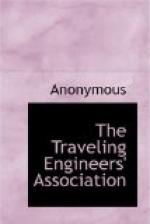A. Any drop in brake cylinder pressure will be felt in chamber “B” below the piston 2, causing a difference in pressure on the two sides of the piston, allowing the pressure in the control cylinder “D” to move the piston 2 down, unseating the admission valves, allowing a further flow of main reservoir air from chamber “A” to chamber “B” and the brake cylinders until the pressure is again slightly greater than that in the control cylinder “D”, when the piston 2 will again move up, allowing the admission valves to close. Thus in this way air will be supplied to the brake cylinders of the locomotive, holding the brakes applied regardless of leakage.
177. Q. Explain the movement of the parts in the control valve, when the automatic brake valve is moved to release position, following an automatic application of the brake.
A. In release position of the brake valve, air from the main reservoir flows direct to the brake pipe, causing an increase of pressure, which is felt in chamber “F” on the upper side of piston 3; this increase of pressure will cause the piston to move down, carrying with it the graduating valve 10 and slide valve 4 to release position. This allows air from the control cylinder “D” and control reservoir to flow through the release pipe “IV” and on to the automatic brake valve, where the port to which this pipe leads is blanked by the automatic rotary valve, which prevents the air leaving the control cylinder and reservoir, thus holding the locomotive brake applied while the train brakes are being released. The movement of the parts are the same where the release is made in holding position.
178. Q. Explain the movements of the parts in the control valve when the automatic brake valve is moved to running position, after having first been moved to release or holding position.
[Illustration: Automatic Control Valve. Service Lap Position. Fig. 23.]
A. In this position of the brake valve the port to which the release pipe “IV” is connected is open to the exhaust, thus allowing the air in the control cylinder and reservoir to escape to the atmosphere. The reduction of pressure in the control cylinder “D” below that in chamber “B” causes the control piston 2 to move up, carrying with it the exhaust valve 7 to release position, opening the exhaust port “N”, thus allowing the air to return from the brake cylinders through ports “C” and “N” to the atmosphere, releasing the brake. (See Fig. 21.)
179. Q. Explain what takes place in the control valve when an automatic emergency application of the brake is made.




